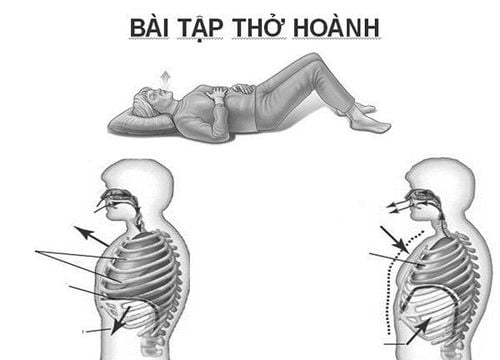This is an automatically translated article.
Some people get very nervous when traveling by plane, while others can become extremely scared at the thought of flying and refuse to go anywhere near the plane. Systematic desensitization is a behavioral technique whereby a person is gradually exposed to an anxiety-provoking object, event, or place while engaging in several types of relaxation at the same time to reduce anxiety symptoms.1. What is systematic desensitization?
Systemic desensitization is an evidence-based therapy that combines relaxation techniques with gradual exposure to help patients gradually overcome anxiety disorders or obsessions about a particular problem. some topic.During systematic desensitization, also known as exposure therapy, the patient will have to overcome levels of fear and anxiety disorders, starting with exposure to the triggering problem. out that obsession slowly. This approach also involves the use of a number of different relaxation techniques. This sets systematic desensitization apart from most other desensitization techniques.
2. Steps to perform systematic desensitization
Systematic desensitization involves three main steps. The patient first learns muscle relaxation techniques. They will then be assisted to make a list of their fears and arrange them in order of intensity from low to high, and finally slowly come in contact with each fear on the list.The desired end goal of systematic desensitization is to replace feelings of fear and anxiety with a state of calm. Therefore, once all of the fears listed above have been overcome, the person will need to continue focusing on relaxing in the face of each of these situations until they no longer cause distress. uncomfortable anymore.

Bài tập thở hoành
2.1. Learning relaxation techniques In systematic desensitization, the patient needs to learn several different relaxation exercises. These exercises can be used individually or in combination depending on the purpose of the technique.
Exercises in the process of learning relaxation skills include:
Diaphragm breathing: The diaphragm is a respiratory muscle, so this exercise requires the patient to learn how to regulate breathing by breathing slowly and deeply through the nose, Hold your breath for one to two seconds then exhale through your mouth. Visualization exercise: The patient will be asked to concentrate on imagining a relaxing scene, focusing on sensory details such as images or smells. This exercise sometimes requires the assistance of others to involve re-describing scenes to stimulate the imagination of the patient. Muscle relaxation: This exercise helps the patient learn to relax and release all muscles in the body. This technique relieves muscle tension and helps the patient to tell the difference between muscle tension and relaxation. Thereby, they will be better aware when muscles begin to tense in response to anxiety as well as fear. Meditation and mindfulness techniques: Learning to meditate helps patients become more aware of their thoughts and feelings when faced with a frightening situation. Meanwhile, mindfulness helps us realize what we are going through in the present moment, thereby reducing negative thoughts and worries. 2.2. Make a Fear List After learning relaxation techniques, the person will be instructed to create a hierarchical fear list for the phobia or feared situation. This hierarchy usually includes 10 levels of fear. To make this list, the patient needs to go through a few steps:
First, the patient determines the most frightening level of their fears and ranks them in the 10th position, corresponding to the level of fear. level 10. Next, the patient determines the lowest fear level of their fears and ranks them in first place, corresponding to the fear level of 1. The patient is then instructed. List levels of fear between 1 and 10 and arrange them according to the level of fear perceived by the patient. For example, seeing a picture of the patient's fears can be level 3 while actually touching them can be level 8 or 9. Next, the person will develop expressions of self. cope with each level of fear with the help of a therapist.

Kỹ thuật thư giãn
2.3. Gradual Exposure to Fears Once relaxation techniques have been learned and a systematic list of fears has been learned, the patient can begin to gradually expose them to a fear scale from low to high. .
The first step is to think about the problem the person is afraid of. Once you begin to feel fear or anxiety, you will be asked to apply relaxation techniques to regain a sense of calm. This process is repeated until the patient no longer feels fear or anxiety.
Once the person is able to comfortably deal with one level of fear, the person will move on to the next higher level and so on until they can completely release themselves from all 10 levels of fear. .
3. Some examples of systematic desensitization
The systematic desensitization process is different for each person. Some people can overcome fear quickly in the lower levels but find it difficult to overcome the higher levels of fear.
Others may take longer to overcome low levels of fear, but they easily face higher levels of fear afterward. Here are 2 examples of the application of systematic desensitization in real life:
3.1. Social Anxiety Disorder Imagine yourself as a college student with social anxiety disorder, always dreading the thought of giving wrong answers in class or getting upset every time you have to use the house. public toilets. You speak less in class as well as participate in school activities to avoid embarrassing situations.
When you decide to apply systematic desensitization, you identify talking to strangers as a level 1 fear. You will imagine yourself greeting people, trying to take deep breaths and apply pressure. Use the relaxation exercises you've learned to regain your composure.

Chứng rối loạn lo âu xã hội
Next you need to proceed to greet strangers in real life, try to breathe deeply and calmly when talking. After about a week you will feel more comfortable in this. Do the same with the levels of fear on the list until the last one involves speaking up in class. This takes a few tries, you can finally answer the questions. Try to take a deep breath, release the tension and tightness in the muscles and start speaking.
3.2. Fear of Dogs People with dog-related phobias often sweat profusely, have heart palpitations, and find it difficult to breathe when a dog approaches. This phobia is often directly related to being bitten by a dog, leading to fear every time around them.
Begin a hierarchy of fears by imagining yourself near a dog walking in the park with its owner on a leash. Then it's going to jobs that gather a lot of dogs, parking and choosing a place where you can see the whole of the park. The patient will feel stressed every time a dog starts barking. To combat this they need to apply the relaxation techniques they have learned and imagine themselves on a beautiful beach where there are no dogs. Then open your eyes and repeat this process every 30 minutes.
The next level is to visit a friend who has a dog and imagine the scene going to face it.
The final level could be a walk through a job with many dogs. Patients will likely be exposed to puppies before proceeding to conquer this greatest fear level. Puppies are less intimidating and more intimate.
It will always be hard work for everyone to face their fears. Especially for people with certain mental health problems such as obsessive-compulsive disorder, anxiety or panic disorder.... Then systematic desensitization may be the right approach to help. You overcome your fear.
Systematic desensitization is relatively different from other desensitization techniques as you need to face your fear in gradually increasing gradations until you feel truly calm in the face of your fears. that fear.
Please dial HOTLINE for more information or register for an appointment HERE. Download MyVinmec app to make appointments faster and to manage your bookings easily.
References source: healthline.com, psychologynoteshq.com, verywellmind.com













